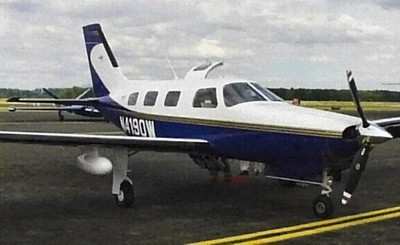Pilot Said Airplane Lost Power On Approach To Harrisburg International Airport
The NTSB has released a preliminary report from an accident which occurred on October 4 involving a Piper PA46-310P which was involved in a forced landing in the Susquehanna River.

According to the report, the airplane lost engine power while on approach to the Harrisburg International Airport (KMDT), Harrisburg, Pennsylvania. The private pilot and a passenger sustained minor injuries. Visual meteorological conditions prevailed, and an instrument flight rules (IFR) flight plan was filed for the personal flight which originated at the Greater Rochester International Airport (KROC), about 1600.
In a written statement, the pilot stated he conducted a "thorough" preflight inspection and had the airplane serviced with 30 gallons of 100LL gasoline. He estimated that the 122-gallon fuel system contained 77 gallons of fuel at departure.
The pilot described the flight as "unremarkable." He said that he flew an extended right downwind leg of the traffic pattern, turned and intercepted the final approach course, and was cleared for the visual approach to runway 31 by the MDT tower controller. The pilot said he referenced the course and glideslope indications for the instrument landing system ILS RWY 31 approach during the descent.
According to the pilot, "I had the ILS loaded and was tracking the final approach course and glide slope as I dropped the gear. I added the first notch of flaps and the engine cut out. I pitched for best glide speed as I tried to restart the engine, advanced the power, and switched fuel tanks, none of which worked. We were losing altitude quickly. I retracted the gear and prepared for a water landing. I advised the tower that we were not going to make the runway. I would estimate that we touched down 1-2 miles from the runway."
The pilot held a private pilot certificate with ratings for airplane single engine land and instrument airplane. His most recent FAA third class medical certificate was issued June 10, 2019. The pilot reported 1,502 total hours of flight experience, of which 433 hours were in the accident airplane make and model.
According to FAA records, the airplane was manufactured in 1984 and was powered by a Continental TSIO 550C 310-horsepower engine. Its most recent annual inspection was completed March 1, 2019 at 5,085 total aircraft hours, and the airplane had accrued 20 hours since that date.
The engine had accrued 2,381.7 hours of total time, of which 74.7 hours were since major overhaul.
Examination of the wreckage revealed the airplane was intact, but that the fuselage was deformed aft of the cabin door. Both wings were cut at their roots by recovery personnel. Prior to removal of the wings, each wing was drained of fuel and water. The left wing contained 12.5 gallons of fuel and 10 gallons of water. The right wing contained 17 gallons of fuel and 15 gallons of water.
Flight control continuity was confirmed from the flight controls to all flight control surfaces. Fuel system continuity was confirmed from the roots of each wing to the fuel metering unit. Electrical power was applied to the fuel boost pumps in each wing, and both operated when energized.
The engine spark plugs were removed from the top of each cylinder. Each spark plug displayed normal wear and evidence of exposure to water. The engine was rotated by hand at the propeller; both magneto impulse couplings "snapped," and spark was produced at the ignition leads of the top six spark plugs.
The engine retained for further examination.
(Source: NTSB. Image from file. Not accident airplane)
 ANN's Daily Aero-Term (04.24.24): Runway Lead-in Light System
ANN's Daily Aero-Term (04.24.24): Runway Lead-in Light System ANN's Daily Aero-Linx (04.24.24)
ANN's Daily Aero-Linx (04.24.24) Aero-FAQ: Dave Juwel's Aviation Marketing Stories -- ITBOA BNITBOB
Aero-FAQ: Dave Juwel's Aviation Marketing Stories -- ITBOA BNITBOB Classic Aero-TV: Best Seat in The House -- 'Inside' The AeroShell Aerobatic Team
Classic Aero-TV: Best Seat in The House -- 'Inside' The AeroShell Aerobatic Team Airborne Affordable Flyers 04.18.24: CarbonCub UL, Fisher, Affordable Flyer Expo
Airborne Affordable Flyers 04.18.24: CarbonCub UL, Fisher, Affordable Flyer Expo



